Learn how to make a sourdough starter the easy way. You will learn all about what a sourdough starter is, what you need to make one, how to make it without endless feedings and wasteful discard, and why the whole process doesn't have to be as difficult and time-consuming as you think!
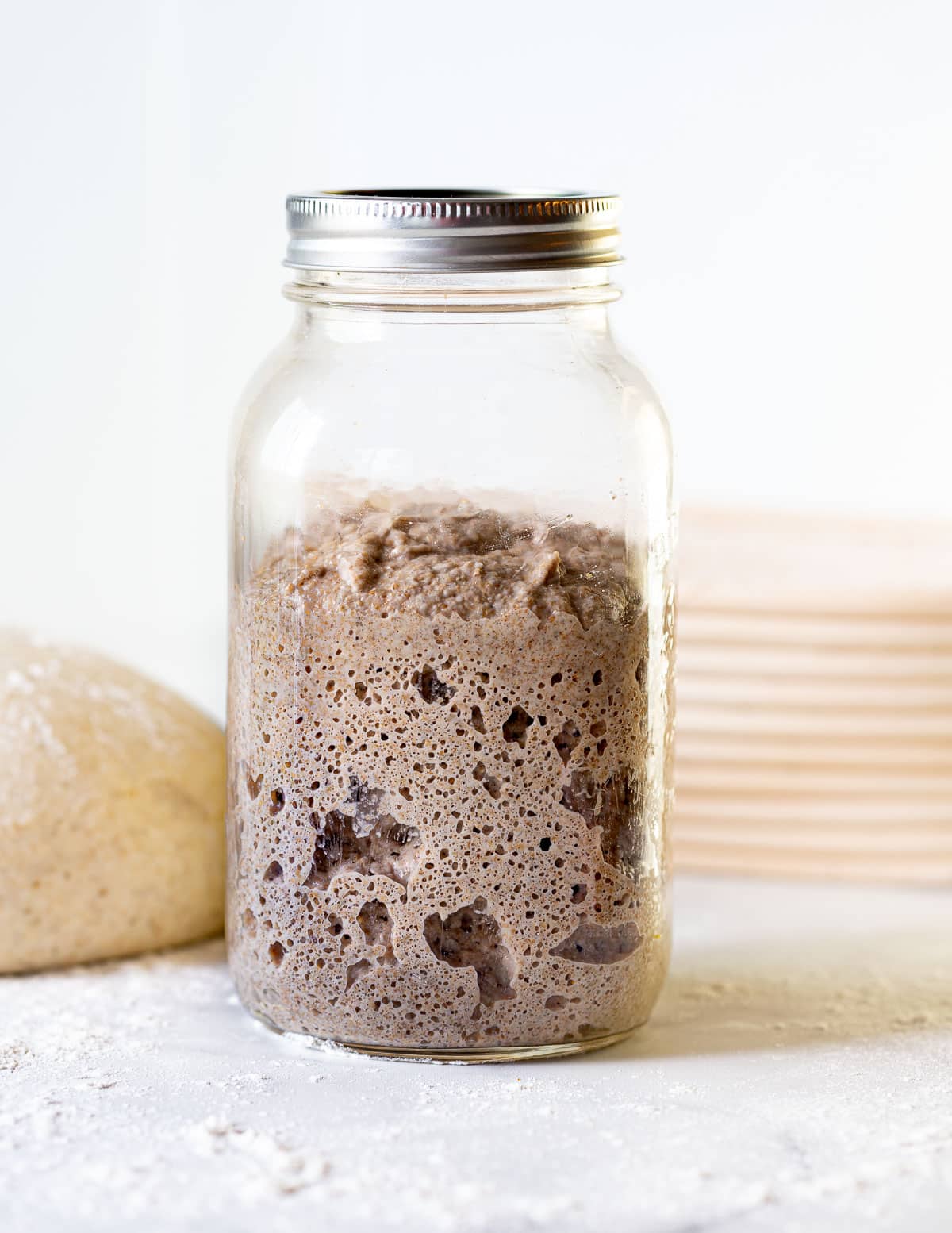
💌 SAVE THIS RECIPE!
Watch out for more tasty treats coming your way too! Unsubscribe at any time.
FEATURED COMMENT:
"All my attempts at making my own starter have failed, including a gifted starter from a famous local baker making super delicious breads and pastries. Here you come to the rescue! Just wow! Only 3 weeks into it … all my bakes have been texturally wonderful and delicious! I have to say the rye flour is the key to this superstar starter. Thank you for sharing and teaching us your knowledge and experience!!!" - Lea ⭐️⭐️⭐️⭐️⭐️ More reviews →
Question for you? Are you ready to learn how to make a sourdough starter? Or let me rephrase...
Are you ready to unlearn everything that you think you know about making sourdough starters and re-learn that it doesn't have to be as difficult as everyone in every cookbook and recipe on the internet makes out?
Yes!!! I was hoping you would say that. Because actually, a sourdough starter is pretty easy to make and look after.
Mel x
This post is long, detailed and contains lots of essential information. I recommend you read the entire thing before making a start, but when you come back to it again, feel free to jump to where you want to be via the table of contents below:
Jump to:
- What Is A Sourdough Starter?
- What Is Wild Yeast?
- What Do You Need To Make A Sourdough Starter?
- The Best Container For Sourdough Starter
- The Best Flour For Sourdough Starter
- Can I Mix Flours In My Sourdough Starter?
- Feeding Sourdough Starter
- Do You Have To Discard Sourdough Starter Every Time You Feed It?
- How Do I Know When I Can Bake Bread With It?
- How To Make A Sourdough Starter From Scratch With No Discard
- Sourdough Starter Names
- How To Keep A Sourdough Starter Warm
- Sourdough Starter Success Tips
- My Starter Is Bubbly & Consistently Rising & Falling, Now What?
- How Soon After Feeding Can I Use Sourdough Starter?
- What Do I Do If I Want To Make Something Other Than Bread With My Starter?
- How Much Sourdough Starter To Use
- How Much Sourdough Starter To Keep
- What Can I Make With Sourdough Starter?
- A Sourdough Starter Insurance Policy
- What Equipment Should I Gather In Preparation For Making My 1st Loaf Of Bread?
- Why Measure In Grams and not ounces or cups?
- Important To Bear In Mind
- Sourdough starter FAQ
- Recipe
- More Easy Bread Recipes
- Reviews & Questions
Most recipes online are just plain mind-boggling with lots of complicated steps and unfamiliar terms and math ... I mean, I hated math at school, and I sure don't want to be calculating complicated percentages when all I want to do is make a loaf of bread.
So I am here to demystify it. This is my simple, no-fuss guide to making a sourdough starter. I want to make the whole process accessible and approachable.
I want anyone, whether a natural baker or not, to be able to come along and learn to make a sourdough starter and a basic loaf of sourdough bread without getting confused over a million different complicated steps and without having to negotiate unfamiliar baker's terminology.
Of course, there is a time and a place for the proper terminology, baker's percentages and dough hydration, etc, but the average person isn't bothered with all that. They just want to come along and make an uncomplicated, easy starter, then knock out a pretty decent loaf of bread once it's ready. That's it.
So if you are that average person who just wants to learn to make a sourdough starter with no fuss and no complicated instructions, then you are in the right place.
And if you don't want to be making massive jars of starter that grow and grow, take over your entire kitchen and need feeding twice a day without fail for the rest of your life, while you try to figure out what to do with the massive amounts that you are told to discard, you have also come to the right place.
I am going to teach you what you need to know to make a happy and thriving starter, without any of the superfluous details that you don't need to know, and it's all going to be done waste-free! Yep, you heard me right. No discard.
What Is A Sourdough Starter?
A sourdough starter is a live culture which you can use to leaven (rise) baked goods by adding a small amount to the dough. It's the oldest form of leavening bread, and is thought to originate from ancient Egyptian times.
A sourdough starter is created by mixing flour and water and then allowing the mixture to sit for some time. During that time, it begins to ferment, and wild yeast, which are already present in the flour and the air around us, will start to grow and thrive as long as conditions are right.
The yeast eats the natural sugars in the flour and converts it into lactic (and other) acids, which is what gives sourdough its characteristic tang. Carbon dioxide is produced by the yeast during this process, and this is what makes the starter, and the bread you bake with it rise.
When you make bread with a sourdough starter, you do not need to use commercial yeast.
What Is Wild Yeast?
Wild yeast is all around us, in the air, in our grains/flour and on the surface of fruit, and it was used in baking long before commercial yeast became available.
Commercial yeast is reliable and fast, whereas wild yeast is slow, a little temperamental and needs looking after. Having a starter is almost like having a real, live Tamagotchi or pet to look after.
So you might be wondering why you'd even bother. Why not just use commercial yeast if it's quicker and easier?
Well, for starters (excuse the pun!), it's fermented and, for many people, is easier to digest than bread made with commercial yeast. Secondly, you know I'm all about flavour in my recipes and everything I eat. Well, sourdough bread is FULL of complex flavour and amazing texture in a way that bread made with commercial yeast can't even get close to. And lastly, making it is an art. It's challenging, fun, rewarding, and so worth the extra time and effort it takes to make!
What Do You Need To Make A Sourdough Starter?
The ingredients list is pretty basic:
- Flour
- Water
That's it.
And the equipment you need is also pretty basic:
- A jar/container to keep the starter in and a lid for it (see just below for advice on style/size).
- A digital kitchen scale. Please don't use cups to measure when making bread or starter. Baking is a science, and cup measurements are not accurate enough if you want excellent results. In my sourdough recipes, I will be asking you to weigh all of your ingredients, including the water. You can pick up a digital kitchen scale for under $20.
- A spoon or spatula that can easily reach into the bottom of the container/jar. I like these jar spatulas because they are long and thin and make stirring and scraping the jar easy.
- An elastic band to use to mark the level your starter is at after feeding. This isn't essential, but it makes it really easy to see how much your starter has grown and when it is ready to use.
The Best Container For Sourdough Starter
A wide-mouthed, clear glass jar of between 750 ml (25 oz) and 1 litre (34 oz) is perfect. Something like a mason jar, a Weck jar, or a cleaned-up store-bought peanut butter/marinara sauce jar.
It should be clear so you can see inside easily, wide so it's easy to spoon the flour into and the starter out of, and a decent size so that when the starter rises, there is no risk of it spilling over.
I started out with recycled glass jars from the pantry and have now upgraded to Weck jars. They really are perfect. Wide, smooth sides for easy stirring, and the glass lids without the rubber seals and clips are ideal for covering the starter without making it airtight.
The Best Flour For Sourdough Starter
Technically, you can use any good-quality unbleached flour to make a sourdough starter, but some flours create more demanding or vigorous starters than others.
Common flours to use when making starters are all-purpose flour, bread flour, or whole wheat flour, but for this easy starter recipe, you need to use rye flour.
Using rye flour makes the process almost foolproof. Your starter will come to life a lot quicker than starters made with other flours, and it will get more nutrients, so it will be able to cope well with the small feeds required in this recipe. Other flours will not work in this recipe.
The rye flour you use must be fresh. Don't use a bag of flour that has been sitting open in your pantry for the last 6 months. If you want your starter to be healthy and happy, you need to feed it fresh food.
We might start the process all full of enthusiasm and excitement, but there will come a time when you forget to feed your starter for a few weeks or leave it in the back of the fridge for 3 months ... Yes, I did that to my starter .... Sorry, Percy. A rye flour starter will be much more forgiving and willing to spring back to life after that than any other.
In fact, if you already have a starter made with another flour that doesn't appear to be flourishing or that you think is dead, feed it some rye flour and watch it come back to life again. They just love it!
And don't worry, just because you use rye flour to make your starter, it doesn't mean you can only make rye bread. You can use your rye starter to make white or whole-wheat bread.
Can I Mix Flours In My Sourdough Starter?
You can use a mix of different flours, like all-purpose flour mixed with rye flour or whole wheat flour, in your starter once it is established, but you might find you need to feed it more, which will mean it's harder to keep discard-free. When starting out, though, I recommend using 100% rye flour because you are going to get it up and running faster, and it will be much more resilient.
Try not to chop and change the brand of flour you use to feed your starter when you are getting it established. Be consistent and use the same for every feeding if at all possible. It will make things a lot more predictable and progress easier to track.
Once you are up and running, you can use a bit of your established starter to start new and different starters. If you have a rye starter, use a little bit of it to "seed" a new whole wheat or white flour starter. You'll have a new and happy, thriving starter almost immediately, although bear in mind that using different flours will change the feeding requirements and could mean you have to discard.
Feeding Sourdough Starter
When you make a starter, you are cultivating wild yeast. To keep it happy and make it thrive, you have to feed the wild yeast living in your starter.
Feeding is as simple as adding more flour and water. You open the jar, put it on a scale, add equal parts flour and water, stir it all up, pop the lid back on loosely and put the container back wherever you keep it.
Then, within a few hours, the wild yeast will have a party, go crazy, and your starter will begin to bubble and rise to about double its size. When the wild yeast has consumed all of the natural sugars in the flour, they will calm down, go to sleep, and the starter will slowly fall back down as carbon dioxide stops being produced.
Do You Have To Discard Sourdough Starter Every Time You Feed It?
Most recipes will have you feeding your starter every day. Sometimes twice a day. They will also have you discard half of it each time. This is so wasteful and unnecessary.
With my recipe, you do not have to discard the sourdough starter every time you feed it. Instead, you feed the starter every day with equal amounts of flour and water without discarding any while you are getting it established, then once it is established (after a week or two) you only need to feed it the day before you want to make bread.
Then you will use all but a teeny tiny amount of the starter in your baking and leave the rest (which amounts to just the scrapings in the jar ) in your fridge until the next time you bake. When that time comes around, you will feed the starter the day before you need it, using only as much flour and water as you need to make the amount of starter required by your recipe.
There really is no good reason to keep masses and masses of starter bubbling away, and there's even less of a good reason to be wasting flour every day when you don't need to.
How Do I Know When I Can Bake Bread With It?
Once your newborn starter looks really bubbly, like the inside of an Aero bar or chocolate mousse, and doubles after you feed it, it is ready to start baking with, and it will continue to get stronger as it gets more mature.
The optimum time to prepare bread dough with your starter is when the starter has reached its peak after feeding. You will get to know what this looks like once your starter is established and you have seen it rise and fall.
Then, when you mix the starter with the fresh flour, water and salt needed to make your loaf, it is provided with more food. It eats the natural sugars in the flour, and carbon dioxide is produced, which causes the dough/bread to rise.
How To Make A Sourdough Starter From Scratch With No Discard
(For detailed measurements and instructions, see the printable recipe card).
It is really easy to cultivate your own sourdough starter. There are lots of different recipes out there, but they tend to be complicated and very wasteful. My recipe is as simple as it gets. Flour, water, and time. That's it. And you won't have any excess starter to discard!
Here's how:
Day 1 - Get a clean jar. Add to it 25 grams of flour and 25 grams of room-temperature water. Mix well so you can't see any dry flour, level it as best you can and cover loosely with a lid. Don't screw the lid on tightly. If you have an elastic band, put it over the jar, and level with the top of the starter (to measure progress). Leave the jar in a sheltered, draft-free spot for about 24 hours. It doesn't have to be exact. An hour less or a few hours more is fine. If your room is cooler than 20°C (68°F), you will speed things up greatly if you can increase the temperature a bit. See my tips under the heading "How to keep a sourdough starter warm" below for how to keep your starter nice and cozy.
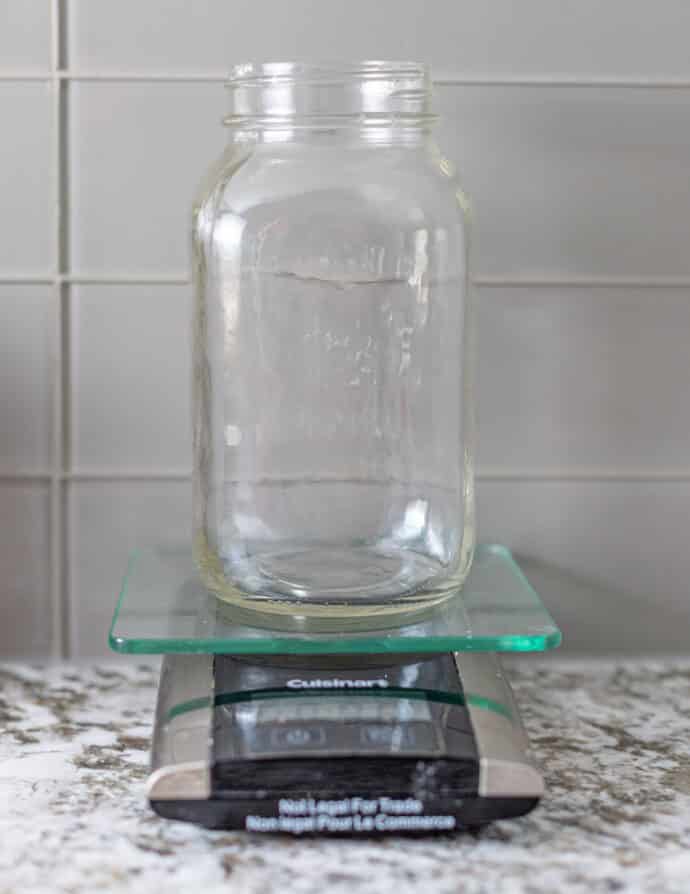
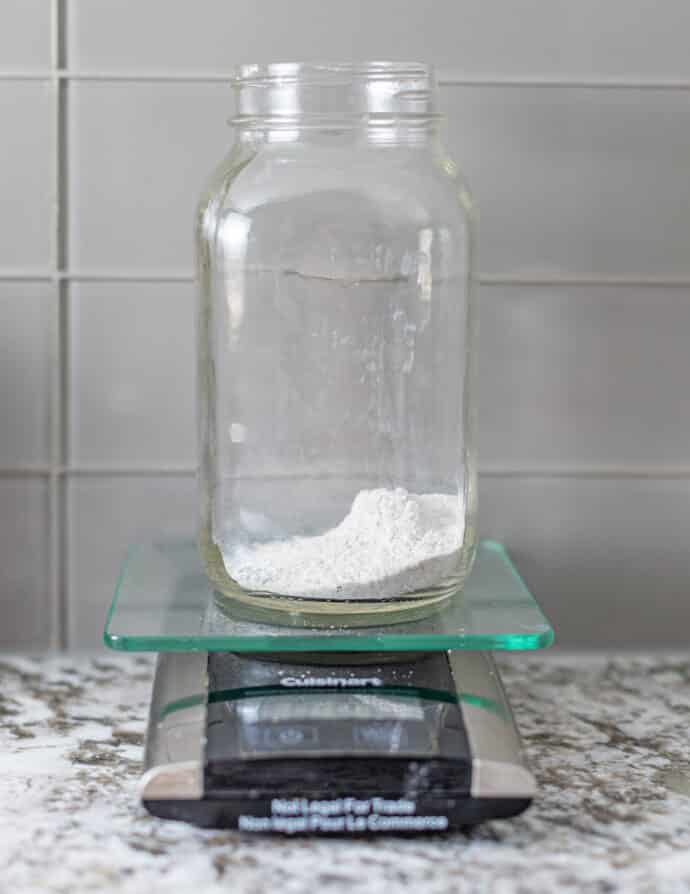
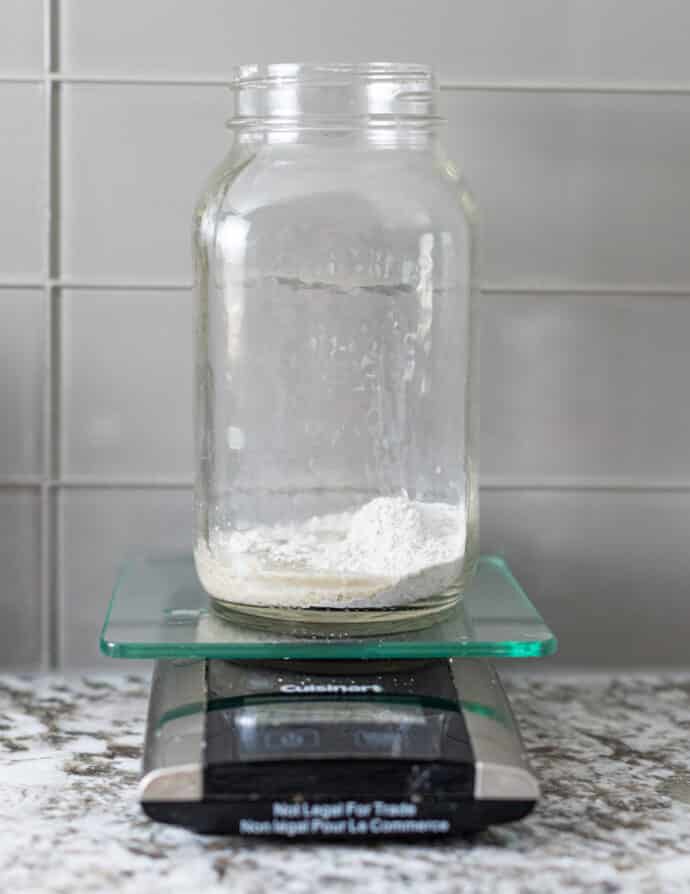
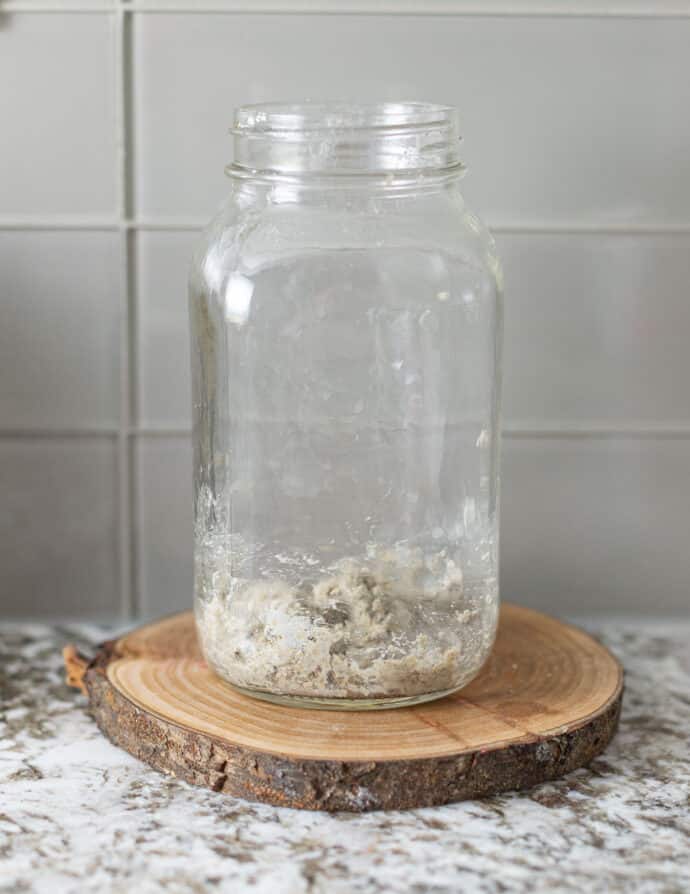
Day 2 - It probably won't look any different today but may smell a little milky or fruity. It might have a bubble or two or it might not. Uncover the jar and add another 25 grams of flour and 25 grams of water. Stir, level again as best you can and leave loosely covered again for about 24 hours.
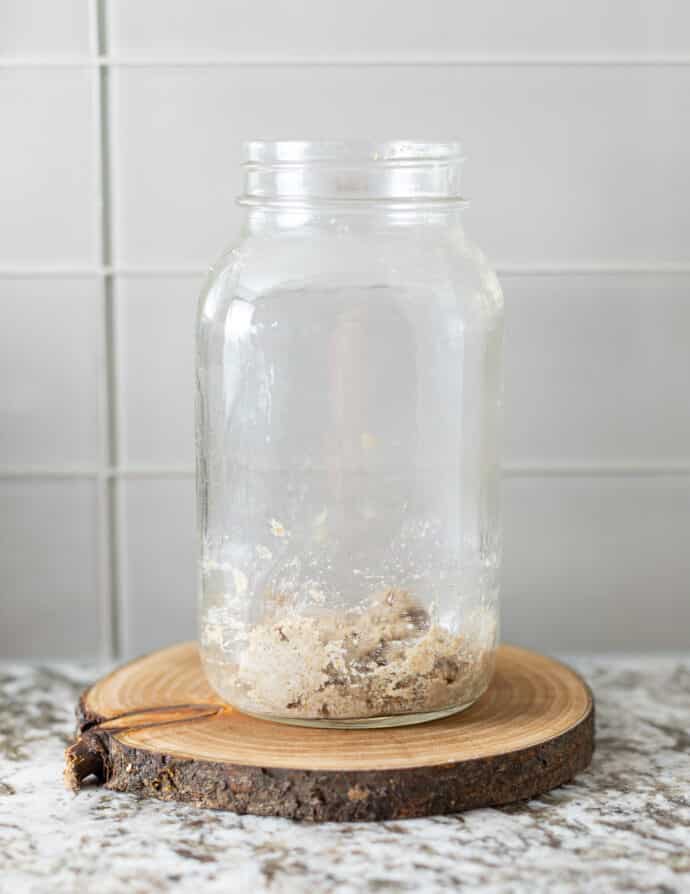
Days 3 to 7 - Repeat this process daily for the next 5 days. DO NOT discard any of the starter.
After day 2 or 3 - You will probably start to see a few bubbles forming and notice a slightly milky or fruity smell when you sniff it. You could also get a sudden burst of bubbly/rising activity. This sometimes fools people into thinking it's ready, then the activity suddenly stops again and they are left thinking their starter died. Just keep going if this happens. It's common (but doesn't happen to everyone) and is due to different bacteria in the flour which will die off as the starter ferments and the PH changes. It will all go quiet then the good guys will take over and things will start happening for real. Progress is different for everyone though so don't worry if nothing appears to be happening. Just keep going with the daily feedings.
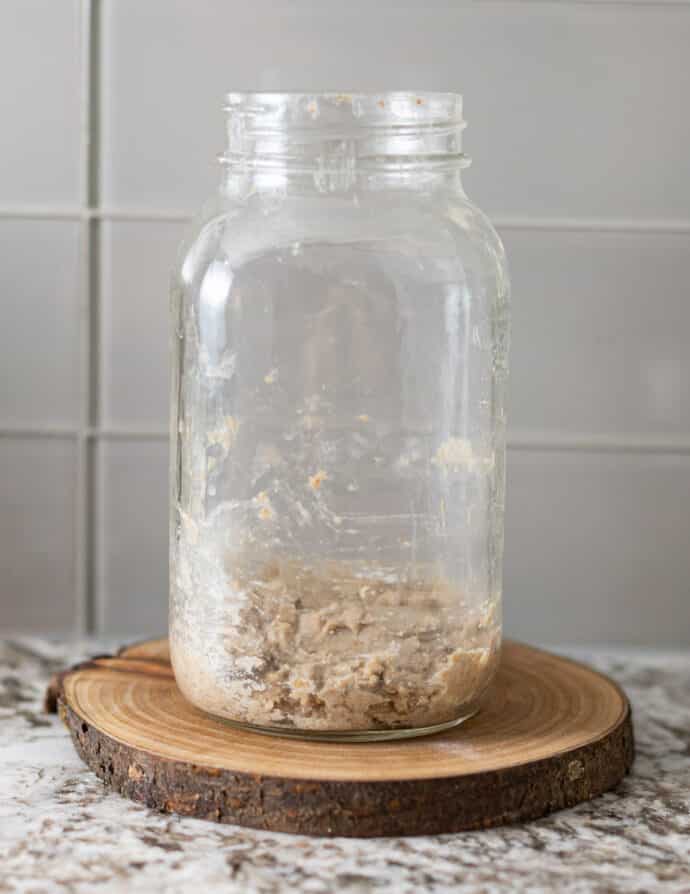
From days 4 to 6 changes to the appearance and smell should be very noticeable. You should be seeing bubbles and it should be rising a little between feedings. Again though, don't worry if yours is a little slow. Just carry on regardless, feeding it every day with 25 grams of flour and 25 grams of water.
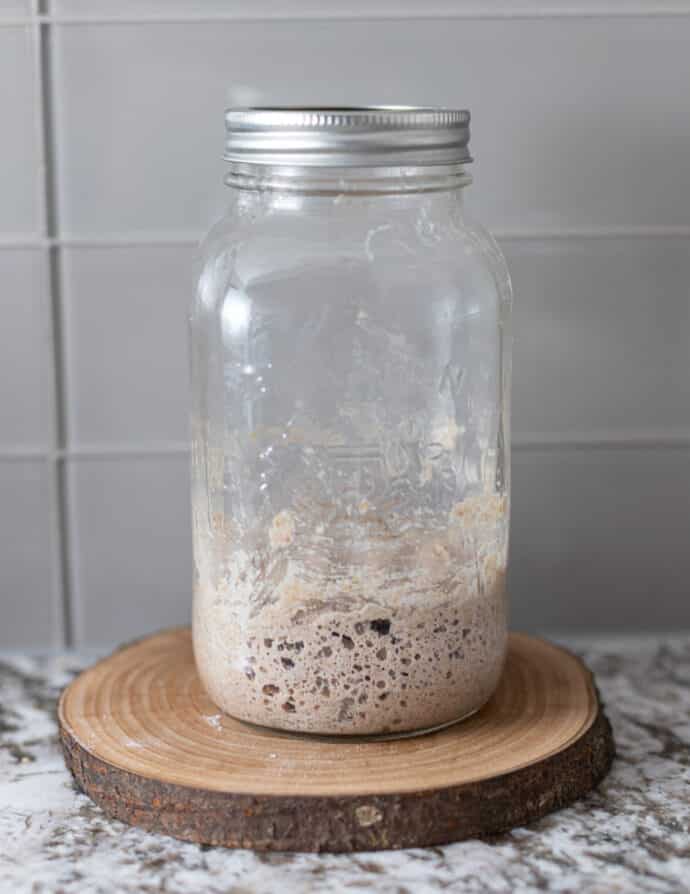
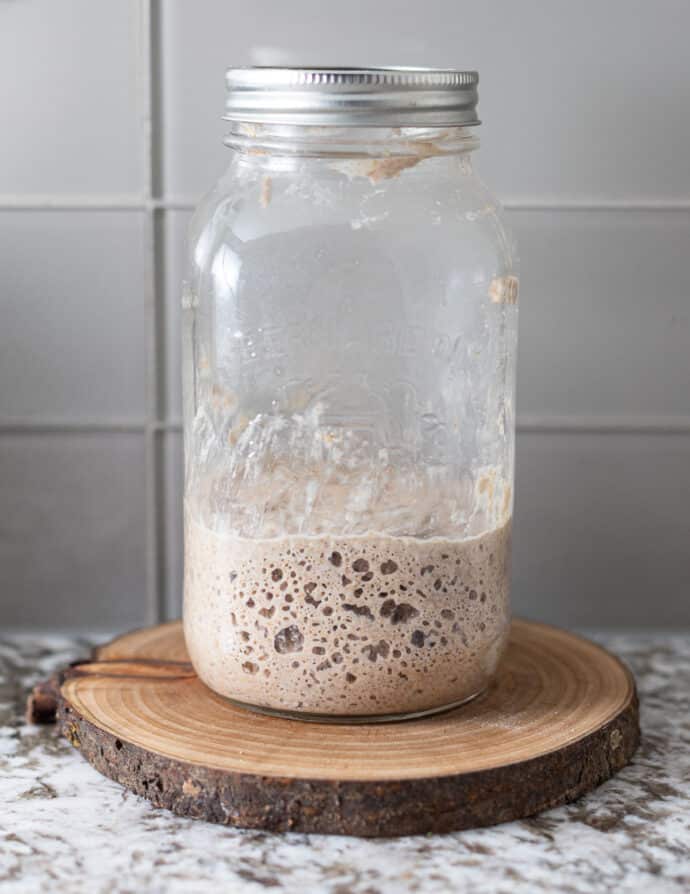
From days 7 to 8 your starter should be getting really bubbly after feeding and it should be starting to rise and then fall reliably and predictably after each feed. Again though don't worry if yours isn't. This process can be unpredictable. Just keep going but try to keep it somewhere a little warmer as that will help. See my tips under the heading "How to keep a sourdough starter warm" below for how to keep your starter nice and cozy.
Here is mine on Day 7:
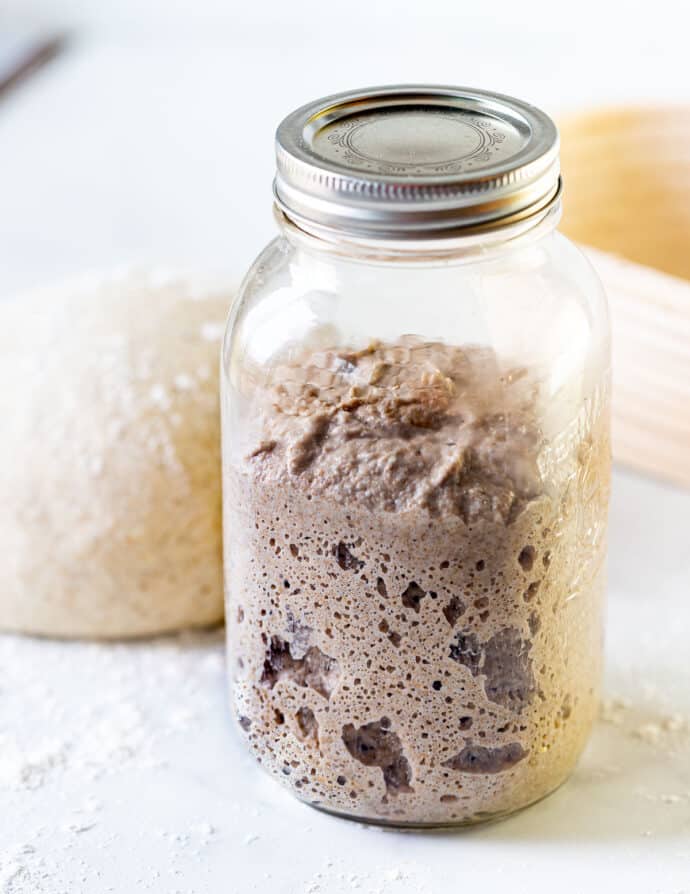
Once your sourdough starter is reliably doubling in size after feeding and looks really spongy, fluffy and bubbly like mine in the picture above, it is ready to make bread with.
Well done! You made a sourdough starter!
Sourdough Starter Names
Now that you have your own living and breathing sourdough starter, you need to hold a naming ceremony and make it part of the family. It's an essential right of passage into the sourdough bread baking world ;O)
Here are some fun sourdough starter names for inspiration:
- Doughreen
- Bread Pitt
- Jane Dough
- Gloopy
- Little Bread Rising Hood
- Clint Yeastwood
- Bubbles
- Frankendough
I currently have two. Percy and Michael Bubbly!
Here is Percy, my old sourdough starter. I think he's about 20 years old. He was born and bred in England, then got rudely dehydrated on a piece of paper and flown to Canada, where he started a new life. Charlie (the dog) loves the smell of him and is there by my side for every feeding and bake session!
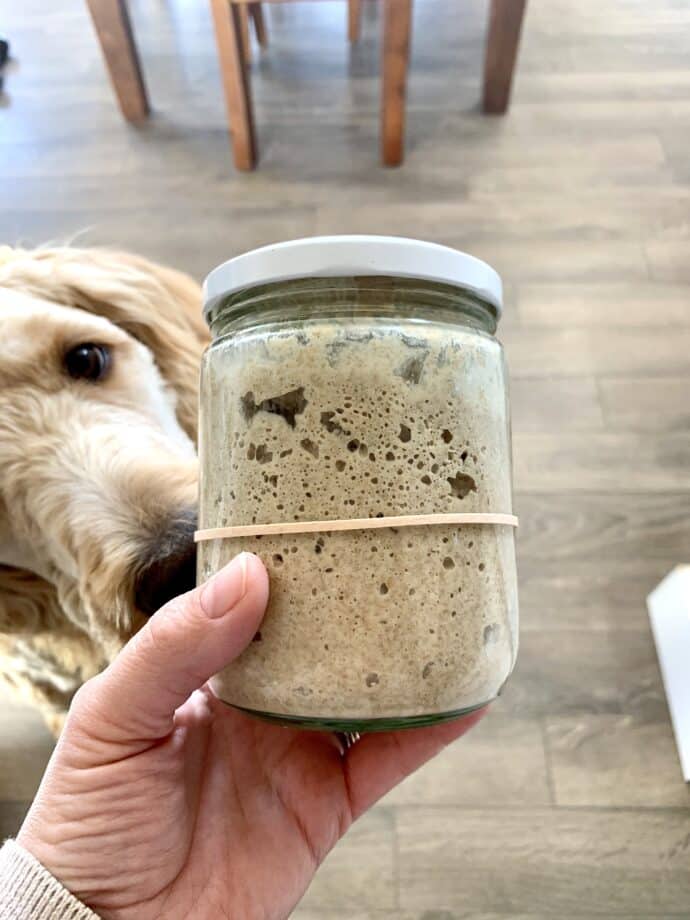
How To Keep A Sourdough Starter Warm
To get things moving along quickly, a temperature between 20°C (72°F) to 26 °C (80°F) is perfect. Some of us are lucky and have an environment naturally at that temperature, but if the room you keep your starter in is cooler then things will move along quite slowly. To be clear, it will still happen if it's cooler, it will just take much longer.
Here are some ideas to provide your starter with a warmer environment to help speed it up:
- Move it to another room - You might have one room in your house that gets warmer than others. Try leaving it in there.
- Use the light in your oven - Simply place the jar of starter in a cold oven and turn the light on. The heat from the bulb will keep your starter warm. Just make sure no one comes along and turns the oven on while it's in there!
- Use your home heating - Place the jar of starter near (but not too near) the furnace, radiator, fireplace, or stove.
- Use an Instant Pot - If your Instant Pot has a yogurt setting, set it to low and place the jar of starter on the trivet inside. It's important to leave the lid off the Instant Pot as otherwise it will get too hot for your starter.
- On top of your fridge/fridge freezer - This is usually a nice warm spot and works well if you don't have built-in appliances.
- A sunny windowsill - Don't put it in direct contact with the sun, as it could damage your starter, but put it in indirect sunlight or in a dark box on the windowsill to protect it.
- In the airing cupboard - If you are in the UK in an older-style house, you might well have one of these.
- A warm closet - I have forced air heating in my house, and the closets have vents in them and get really warm. My starter loves it in there!
Sourdough Starter Success Tips
- Read this entire post before you begin. Everything here is useful and will set you up for success.
- Always weigh your ingredients. That means the flour and the water. When baking (which is what you will ultimately do with this starter), it is really important to be precise and cups are not precise enough. You can pick up a digital kitchen scale for under $15.
- Use rye flour for the easiest and hardiest starter.
- Do not use old flour. You wouldn't feed a baby old milk. Your starter needs fresh food that's full of nutrients, just like a baby does. If you use old flour, your starter will likely be harder to get goin,g and there's a strong chance it will end up getting mouldy.
- Do not use bleached flour.
- Don't be tempted to deviate from the recipe.
- Don't rush it. It takes as long as it takes, and patience is important.
- Don't store your starter in a metal container.
- Once established, only make as much starter as you need for your recipe and keep the scrapings in the jar for next time. If you accidentally end up with too much, use it up in a recipe that calls for sourdough starter discard.
- Read through my FAQ if you run into any problems. I've tried to think of all the possible situations you could run into along the way and provide an answer. However, if you get stuck, feel free to reach out, and I will do my best to help.
My Starter Is Bubbly & Consistently Rising & Falling, Now What?
You have a happy and thriving sourdough starter, and you are ready to make bread.
Let's say your starter took 7 days to establish. That means that you now have 350g of sourdough starter in your jar.
25g of rye flour + 25g of water = 50 g
50 g x 7 days = 350g
.... I promise that's the extent of the math involved.
You can now remove all of that starter from the jar and use it for baking bread, or any other recipe that uses starter. You just need to leave the scrapings behind (the clingy bits that are left on the bottom and sides). These clingy bits are all you need to keep your starter going.
Put the (almost) empty jar with clingy bits in the fridge and leave it there until a day or two before you want to make bread again.
Here is my jar of sourdough starter scrapings:
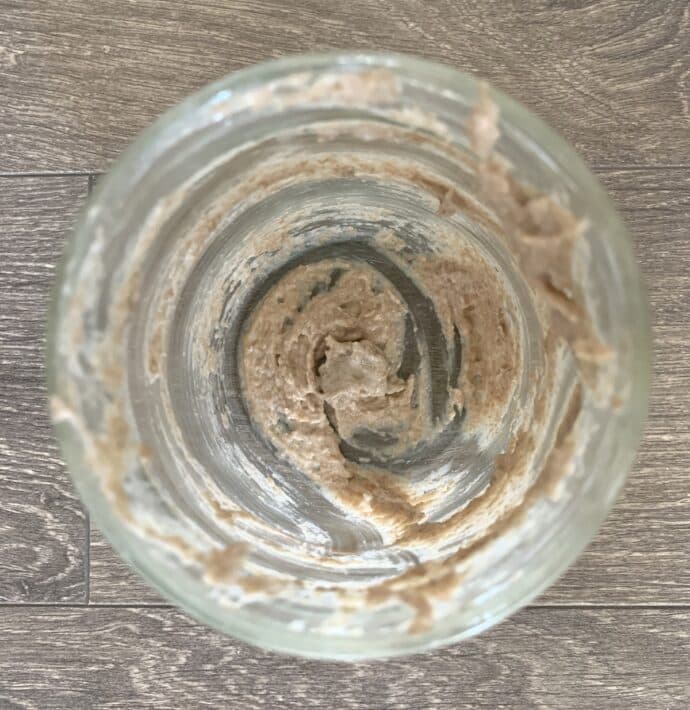
Then next time you want to bake:
- If a week or less has passed since you put the jar in the fridge - the night before you want to bake, read your recipe and see how much starter it calls for.
If it says you need 100 g of starter, put 50g of flour and 50g of water into your starter jar and stir it up really well. 50 g + 50 g = 100 g, which is what you need for the recipe.
If the recipe says you need 300g of starter, put 150g of flour and 150g of water in your jar. 150g + 150g = 300g.
Get it? Then cover the jar and leave it wherever you keep it, until the next morning, when it should be at its peak and ready to bake with. Take out all of the starter to use in your recipe, leaving the scrapings in the jar and pop it back into the fridge for next time, then follow these directions again the next time you want to bake. - If 2 weeks have passed since you put the jar in the fridge - 2 nights before you want to bake, read your recipe and see how much starter it calls for. You are going to feed the starter over 2 nights to get it excited again.
If your recipe says you need 100 g of starter, put 25g of flour and 25g of water into your starter jar and stir it up really well. Then, the following night, add another 25g of flour and 25g of water. That brings you up to 100g of starter. Leave it until the next morning, and it should be nice and bubbly, and ready to bake with.
If the recipe says you need 300g of starter, put 75g of flour and 75g of water in your jar and stir it up, then the following night add another 75g of flour and 75g of water, stir it up and leave it 'til morning when it should be ready to bake with. - If more than 2 weeks have passed since you put the jar in the fridge - Don't worry. If it's only a few days over 2 weeks, follow my directions above, and you should be fine. If it's much longer, then you might need to feed it over 3 or 4 nights to get it raring to go again. The good news is that it's pretty hard to kill it so no matter how long you've left it, it should be salvageable (unless it's mouldy - see my FAQ below for more info on that).
Don't let the amount of starter you have build up in the jar. Too much and it can get sluggish and struggle to double in size. Just feed it as much flour and water as you need for your bake and no more. If you accidentally end up with too much, use it up by making any recipe that calls for sourdough discard.
How Soon After Feeding Can I Use Sourdough Starter?
After feeding your starter, you need to wait for it to reach its peak before you can bake with it. This time varies from starter to starter and is also dependent on temperature. For me it's about 6 to 8 hours. If it's particularly warm where you are, it could happen more quickly. You will get to know how long yours takes once you've been feeding it for a while.
I feed my starter the evening before I plan to bake with it because I tend to mix my dough in the morning. If you are going to mix your dough in the evening, feed your starter when you wake up in the morning.
What Do I Do If I Want To Make Something Other Than Bread With My Starter?
By making a waste-free sourdough starter, you lose the problem of having to figure out what to do with all of the discard. But sometimes having some extra starter available to make pancakes, crumpets, or waffles is a good thing.
If you want some extra starter available to do this, feed your starter as normal the night before you are baking, but use some extra flour and water so you have more than just the scrapings left in the jar after making the bread. Then you can use it right away or leave it in the fridge until you need it.
If you aren't making bread but want to make something else that calls for discard, simply feed your starter enough to make the amount of discard called for in the recipe a day or two before you want to make it. Take out what you need for your recipe and pop the scrapings back in the fridge for next time.
How Much Sourdough Starter To Use
You might be wondering what the ratio of sourdough starter to flour is when you make bread.
The amount of starter you need to use will be listed in the recipe you are following. It varies from recipe to recipe, but the general rule of thumb is that you use about 1/5th of the amount of flour. So for every 500g of flour, that's about 100g of starter.
The more starter you use, the quicker the progress will be and the less sour your bread will be. If you use less starter, things will take much longer to happen, but you will get more complex flavours and more sourness.
I suggest following recipes as they are written to start with, until you get the hang of things, then you can experiment with amounts to get the balance of sourness and time that you need once you are more experienced.
I don't like my sourdough bread to be too sour, so I never use less than 100g of starter to 500g of flour. That's a perfect balance for me.
How Much Sourdough Starter To Keep
When you use your sourdough starter for baking, all you need to save are the scrapings that are left in the jar. You will feed the scrapings in the jar with more flour and water the night before you want to bake again, and in the meantime, the jar will stay in the fridge. There is no need to keep more starter than that.
What Can I Make With Sourdough Starter?
You aren't just limited to bread when using sourdough starter. Here are some other ideas for using it:
- pancakes or crepes
- waffles
- crumpets
- cake
- muffins
- banana bread
- pizza
- American-style biscuits
- crackers
- pretzels
- bagels
- dog treats
- cookies
- cinnamon rolls
A Sourdough Starter Insurance Policy
Just in case the very worst happens and your starter gets mouldy or dies or put in the dishwasher accidentally (yes, that happened to me once!), you could stash a little bit away as insurance. Keep a tiny bit in a pot or bag in the freezer and change it every 3 or 4 months for a fresh piece, or scrape some wet starter in a thin layer onto some parchment paper and allow it to dry out completely until hard and moisture-free. Then scrape it off and keep it in an airtight jar in the back of the pantry. It will keep just about forever like that.
Hopefully, you'll never need it, but if you do, it will be there ready and waiting to help you get up snd running again quickly.
What Equipment Should I Gather In Preparation For Making My 1st Loaf Of Bread?
While your starter comes to life over the next week or two, you might want to prepare for when you make your first sourdough bread recipe.
For that, you will need:
- a large mixing bowl for mixing the dough
- a Dutch oven or a baking/pizza stone, but a baking tray will do if that's all you have
- a metal roasting pan or baking tray with sides and some boiling water (if you aren't using a Dutch oven)
- rice flour, coarse cornmeal or polenta - This isn't for actually making the bread. It's to ensure your dough doesn't stick to anything. Regular flour does not work well because it just absorbs the moisture from the dough and then sticks. If you've got rice (white or brown) in your pantry, and you have a blender, you can make your own rice flour in 2 minutes. Just pour the rice into the blender and blend until a fine powder. Store in an airtight container.
- a banneton (proofing basket) or a mixing bowl lined with a clean dish towel
- a very sharp serrated knife or a razor blade (or a lame/grignette if you want to get all posh) for scoring the bread.
- a spray bottle filled with water
Amazon sell handy little sourdough starter kits that contain a banneton (proofing basket), a lame and a dough scraper. I bought myself one when I was starting out. The rest of the things you probably have at home anyway.
Why Measure In Grams and not ounces or cups?
(This section has been added post-publication after getting lots of messages about why I recommend measuring in grams and not ounces or cups)
The amounts of flour and water that you use MUST be absolutely exact and the only way to make them exact is to weigh them. Ounces don't go small enough. Grams are the only accurate way to measure very small amounts.
We need to use really small amounts of flour in this recipe so that we don't have to discard anything. If we were using larger amounts that you could potentially measure in ounces it would all build up too quickly in the jar and then we'd have to discard which is something this recipe avoids so that we aren't wasting precious food. That's what makes this recipe different to every other one out there. With every other recipe I have seen, you litreally have to throw away half of your starter every single day. That is something I cannot get behind when it is completely unnecessary.
I absolutely do not recommend the use of cups to measure because they aren't accurate enough for measuring a recipe like this. The measurements need to be absolutely exact so that you end up with a 100% hydration starter (50% water 50% flour). If the amounts of water or flour are even slightly off then the hydration won't be correct and then you will run into all sorts of problems when you come to make a sourdough bread recipe with the starter because they all rely on you having a 100% hydration starter. If it's not you'll end up with your dough being either too dry or way too wet and you won't get a good result.
Sourdough is a science. If it's going to work well you have to weigh. All digital kitchen scales measure in grams and you can pick one up for less than $15. Even the big grocery stores sell them (like Walmart etc). The amount you spend on a scale will be offset very quickly by the amount of flour that you don't have to buy and then throw away every day like you would have to do with any other recipe.
A scale is such a good investment because all of your baking recipes will turn out better if you weigh the ingredients. It might seem like a cup is a cup, but 1 cup of every single type/brand of flour weighs a different amount, and even the way you fill a cup changes how much flour ends up in it. Scooping flour results in about 25% more than spooning it in gently and levelling it with a knife. Because of that, you can never be absolutely accurate when using them and that's why I always bang on about using a scale in my baking recipes and why professional bakers don't use cups to measure. They all weigh because it's the only way to be accurate and consistent.
I have added cup/tablespoon/teaspoon measurements in this recipe (under duress ;O) for those people without a scale, but if you want a good result (in this and more importantly your future bread) then you must use a scale.
Sourdough bread is not easy to make at the best of times until you've got some experience behind you. If you don't have all of the measurements correct you'll just be making the whole process even more difficult for yourself and will likely end up failing.
And that's why I recommend measuring in grams!
Important To Bear In Mind
When your starter is just a few weeks old, it isn't yet fully mature. Although it can bake bread, it won't have the power and strength of a mature starter. It will be quite weak and slow.
It's also important to realize that if you are new to the world of baking sourdough, your technique won't be perfect. That comes with time too.
Sourdough is as much an art as it is a science. For the first little while your bread might not be 100% perfect. Keep using your starter and practicing your technique, and you and your starter will get better and better.
Remember too that no two sourdough starters are the same and everyone's will behave differently. You will get used to your starter's unique characteristics once it's been in the family for a while.
Sourdough starter FAQ
No. Cover it with the lid loosely but don't do it up tightly. We want to cover it to stop anything accidentally falling (or crawling) into the jar, but we don't want to seal it. This is because as the carbon dioxide builds up in the jar, it will create pressure. If you screw the lid on tightly, you could end up with a mini sourdough explosion, which I can tell you from experience is not pretty!
Yes, for most people, tap water is fine to use when making a sourdough starter. If it's heavily chlorinated, though, you might find that filtered water works better. If your tap water is treated with chloramine, some filters, such as Brita, don't filter them out effectively. In that case, you will need to use store-bought spring water. I recommend trying with your tap water, then if you have no luck after 7 to 10 days, switch to filtered or spring water for the second attempt.
Did you use rye as recommended? If so, then this is more than likely temperature-related. Is your house or the room your starter in quite cool (below 20 °C (68 °F) ? Cooler temperatures really slow things down, so although something probably is happening, it's happening so slowly that you can't notice it yet. Try moving the jar somewhere warmer. A warmer room, maybe on top of the fridge, or even in the oven with just the light on.
If the temperature is in range and your rye flour is fresh, then there is a chance your tap water is to blame. Try using filtered or spring water instead.
This liquid is commonly known as "hooch". It basically means that your starter is hungry or lacking nutrients, and you often see it if you miss a feeding or are late to feed. You can pour it off or stir it in. You are more likely to see this if you use white flour because it doesn't contain as many nutrients. That's why I recommend rye flour.
This means your starter is hungry. The strong smell will go away when you feed it.
It's always wise to never have your jar more than half full of unfed starter because it needs room to grow after feeding, and you don't want it to overflow. In most instances with this recipe, and as long as you used a 1 litre or larger jar, this shouldn't happen, but in the rare event it does, simply remove most of the starter from the jar, just leaving a little bit at the bottom (even as little as a teaspoon is fine) and start feeding that small portion. Or transfer a small bit to a new, clean jar and start feeding it there. The excess starter that you removed can be composted, added to the dough of a regular yeasted loaf, pizza dough or used to make pancakes or waffles.
When your starter is fluffy and bubbly and is reliably and consistently rising to about double its height and then falling back after each feed, it is ready to make bread. For most, this will be around the 7 or 8 day mark. Again, though, it is different for everyone. Don't worry if yours takes longer.
No, just because you use rye flour to make your starter, it doesn't mean you can only make rye bread. You can use your rye starter to make any sourdough bread, including white or whole wheat.
This is common with new starters until they mature. Try taking it out of the fridge two days before you bake. Read your recipe and see how much starter it calls for.
If it says you need 100 g of starter, put 25g of flour and 25g of water into your starter jar and stir it up really well. Then, the following night, add another 25g of flour and 25g of water. That brings you up to 100g of starter. Leave it until the next morning, and it should be nice and bubbly and ready to bake with.
If the recipe says you need 300g of starter, put 75g of flour and 75g of water in your jar and stir it up, then the following night add another 75g of flour and 75g of water, stir it up and leave it 'til morning, when it should be ready to bake with and more vigorous. Also, check the temperature of the area where you are leaving your bread to rise. If it's too cool things will take a very long time. Move it somewhere over 21°C (70°F) and you will hopefully see a difference.
This is more than likely temperature/season-related. Keep it somewhere warmer, and things will speed up a bit.
If this happens, then you will need to feed it again and wait for it to reach its peak before you can bake.
Some people never clean the jar. I like to give my starter a new, clean jar about once every couple of weeks. Have the new jar ready when you are about to feed your starter. Scrape the starter out of the old jar and put it into the new jar. Feed as per usual and wash up the old jar.
A healthy starter should smell fruity, yeasty and sour in a pleasant way. If it is hungry, it will smell like alcohol or nail polish remover. If it smells cheesy or foul, then I would recommend composting it and starting afresh.
If this happens a few days after making your first starter, then just keep going with your feeding schedule. It's normal to get a burst of sudden activity and for it to calm down for a while before things really take off.
If this happens to an established starter, though, dispose of all but a really small amount ( just keep a teaspoon or two of it) and start daily feeding with rye flour as per my instructions for making a new starter. It should soon perk up!
You can make your bread less sour by using more starter in your recipe. This might sound counterintuitive, but by using mor,e you are going to make things happen a lot faster. This cuts down the time the flavour has to develop and will make your bread less sour.
Use less starter to make your bread sourer. This might sound counterintuitive, but by using less starter, you will slow things down and give more time for flavour to develop. Try cutting it down by 10% and see what a difference that makes. Decrease it a little more next time if that isn't enough.
Often, if a starter is weak, it's because there is too much of it. Discard all but a tablespoon and begin feeding it daily. You should see a difference quite quickly.
You might have heard that a sourdough starter should pass a float test before you use it. This isn't an accurate enough way to check, though, so I don't recommend you do it. Some starters will float even if they are not ready to bake with, and some will sink when they are ok to bake with. All you need to know is that it is rising to twice its height after feeding and is really bubbly. As long as that happens consistently, then it's ready to bake with and there is no need to perform a float test.
Mould is not good and is often caused by using old flour. Your flour should be fresh to make a starter. The bacteria need the nutrients. You wouldn't feed a baby old milk.
Or it could be that something that shouldn't have been introduced to the jar got in there at some point. Maybe a bit of dirt on a spatula or in the jar. It can also become mouldy if it's left for ages and ages in the fridge without being used. If this happens, there's only one place for your starter to go. That's in the compost bin. R.I.P. I guess you'll be starting all over again. Take note of the tips about having a sourdough starter insurance policy a few paragraphs below.
We've all been there, and yes, it's frustrating. In my recip,e I recommend using room temperature water when feeding your starter. But if you forget to feed it the night before, get up early on your baking day and feed your starter with warm water (not hot) (we're talking about 29 °C (85°F). That should speed things up and hopefully enable you to bake the same day.
If you are reading this after making a starter with another recipe, you can easily switch to this method. Just use up your starter in your baking, saving the scrapings, keep them in the fridge until the night before you are due to bake again, and then follow my instructions for how to feed it up with rye flour the night before you need it.
Phew! I think that's it. This is officially my longest post ever, but I thought it was important to add as much information as I possibly can so that you have the best possible chance of success. I hope it enables you to feel confident in starting out and helps you foresee and tackle with ease any challenges that you may or may not face along the way.
Let me know in the comments: Have you made sourdough before? If not, are you ready to take a chance on my easy, waste-free and fuss-free method for making sourdough? If you have already started the process, how are you getting on? Any questions? Ask away in the comments and I'll get back to you as soon as I can!
Recipe
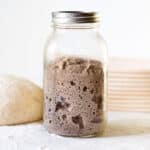
Sourdough Starter Recipe
Author:WATCH HOW TO MAKE IT
Ingredients
- about 175 grams (1¾ cup) rye flour * (plus more as necessary) - please measure in grams if at all possible - see under heading "Why measure in grams and not ounces or cups?" in post above for more info.
- 175 grams (½ cup + 3 tablespoons + 2 teaspoons) room temperature water , (plus more as necessary) (please measure in grams if at all possible).
RECOMMENDED EQUIPMENT
INSTRUCTIONS
- Please start by reading my post above. It's long, but it includes lots of important and useful information that will help you succeed.
- IMPORTANT - I do not recommend using cups/tablespoons to make this starter because they are not accurate enough.
- ALSO IMPORTANT - At no point in this process should you discard any of the starter.
- Day 1 - To a clean jar/container that's between 750 ml (25 oz) and 1 litre (34 oz) in size, add 25 grams (3 tablespoons + 2¾ teaspoons) of rye flour and 25 grams (1 tablespoon + 2 teaspoons) of room temperature water. Mix well so you can't see any dry flour, level it as best you can and cover with the jar lid. Screw it on loosely but don't fully tighten it up. Don't screw the lid on tightly. If you have an elastic band, put it over the jar so it is level with the top of the flour/water mixture. That way you can see easily if there is any increase in volume. Leave the jar in a sheltered spot for about 24 hours, ideally at a temperature of between 20°C (72°F) to 26 °C (80°F) If your kitchen is very cool see my tips in the post above for how to keep your starter warm.
- Day 2 - There probably won't be any changes yet but you might see a few bubbles and/or notice a milky smell. Open the jar of starter and add another 25 grams (3 tablespoons + 2¾ teaspoons) of rye flour and 25 grams (1 tablespoon + 2 teaspoons) water. Mix well so you can't see any dry flour, level it as best you can and cover loosely with a lid, adjust the elastic band so it's level with the top of the mixture and put the jar back in it's spot.
- Day 3 - You might see and smell some changes now. Maybe a few bubbles and a fruity smell. Open the jar of starter and add another 25 grams (3 tablespoons + 2¾ teaspoons) of rye flour and 25 grams (1 tablespoon + 2 teaspoons) water. Mix well so you can't see any dry flour, level it as best you can and cover loosely with a lid, adjust the elastic band so it's level with the top of the mixture and put the jar back in it's spot.
- Day 4 - You will likely see more bubbles today and it could be increasing in volume. Don't get excited and think it's ready to use yet though. Sometimes this happens, then the activity will stop again for a few days, so keep going for now. Open the jar of starter and add another 25 grams (3 tablespoons + 2¾ teaspoons) of rye flour and 25 grams (1 tablespoon + 2 teaspoons) water. Mix well so you can't see any dry flour, level it as best you can and cover loosely with a lid, adjust the elastic band so it's level with the top of the mixture and put the jar back in it's spot.
- Days 5 to 7 - Keep feeding it 25 grams (3 tablespoons + 2¾ teaspoons) of rye flour and 25 grams (1 tablespoon + 2 teaspoons) on days 5, 6 and 7. It should be pretty active and smell pleasantly sour and fruity by now. If by day 7 it has been rising to twice its volume then falling again after each feeding for a few days in a row then it is ready to use for baking bread. If it hasn't been rising to twice its volume consistently after feeding, just keep feeding it 25 grams (3 tablespoons + 2¾ teaspoons) of rye flour and 25 grams (1 tablespoon + 2 teaspoons) daily until it does. Ensure the area it is kept is between 20°C (72°F) to 26 °C (80°F) and no less to give it a boost. See the recipe notes for what to do if your jar starts to become more than half way full after feeding.
- Once your starter has been rising and falling consistently after feeding for a few days it is ready to bake with. Now you must name it and make it part of your family ;O)
- You can use the starter to bake bread when it is at its peak (doubled in size) after feeding. Use what is in the jar for baking with and just leave behind a tiny bit of starter. A few teaspoons is sufficient, or what amounts to the scrapings in the jar. Pop the jar of scrapings in the fridge where it can stay until the day before you bake again. It does not need to be fed in between. The next time you want to bake, remove it from the fridge the evening before and feed it so it's ready and at its peak for you the next day.
NOTES
If it says you need 100 g of starter, put 50g (½ cup) of rye flour and 50g (3 tablespoons + 1 teaspoon) of water into your starter jar and stir it up really well. 50 g + 50 g = 100 g which is what you need for the recipe.
If the recipe says you need 300g of starter, put 150g (1½ cup)of rye flour and 150g (½ cup + 2 tablespoons) of water in your jar. 150g + 150g = 300g.
Get it? Then cover the jar and leave it wherever you keep it, until the next morning when it should be at its peak and ready to bake with. Take out all of the starter to use in your recipe leaving the scrapings in the jar and pop it back into the fridge for next time, then follow these directions again next time you want to bake. If 2 weeks have passed since you put the jar in the fridge – 2 nights before you want to bake, read your recipe and see how much starter it calls for. You are going to feed the starter over 2 nights to get it excited again.
If your recipe says you need 100 g of starter, put 25g ( ¼ cup) of rye flour and 25g (1 tablespoon and 2 teaspoons) of water into your starter jar and stir it up really well. Then the following night add another 25g of flour (¼ cup) and 25g (1 tablespoon and 2 teaspoons) of water. That brings you up to 100g of starter. Leave it until the next morning and it should be nice and bubbly ready to bake with.
If the recipe says you need 300g of starter, put 75g (¾ cup) of rye flour and 75g (5 tablespoons) of water in your jar and stir it up, then the following night add another 75g (¾ cup) of flour and 75g ( 5 tablespoons) of water, stir it up and leave it ’til morning when it should be ready to bake with. If more than 2 weeks have passed since you put the jar in the fridge – Don’t worry. If it’s only a few days over 2 weeks follow my directions above and you should be fine. If it’s much longer then you might need to feed it over 3 or 4 nights to get it raring to go again. The good news is that it’s pretty hard to kill it so no matter how long you’ve left it it should be salvageable (unless it’s moldy – see my FAQ below for more info on that). *FLOUR The flour you use must be rye flour and it must be fresh. Don't use a bag that's been sitting around in your pantry for 6 months or you'll be setting yourself up for trouble. The bacteria need nutrients to grow so you'll have a hard time getting it going and a strong chance of mold appearing at some point if you use old flour.
I recommend using rye flour because it produces a hardier and more resilient starter that will be ready to use a lot quicker than other flours and that will be easier for a beginner to get going and maintain. It also copes really well with the unique maintenance regime of this recipe. Other flours will not. And don't worry, if you make a rye starter you aren't stuck with just having to make rye bread forever. It works fine for making any kind of sourdough bread with flour such as white or whole wheat. IMPORTANT NOTE Make sure that your starter never fills more than half of the jar when you have just fed it because otherwise, it could overflow when it increases in volume. That's why I suggest using a large jar. If it does though, simply remove most of the starter from the jar, just leaving a little bit at the bottom (about a tablespoon is fine), or transfer a tablespoon of it to a new clean jar and start feeding it daily with 25 grams (3 tablespoons + 2¾ teaspoons) of rye flour and 25 grams (1 tablespoon + 2 teaspoons) of water as before. The excess starter that you removed can be used in any sourdough discard recipe. I like to add it to the dough of regular yeasted loaves or pizza dough or I use it to make pancakes or waffles. You can also compost it.
💌 SAVE THIS RECIPE!
Watch out for more tasty treats coming your way too! Unsubscribe at any time.

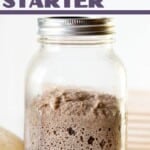
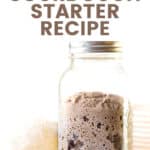
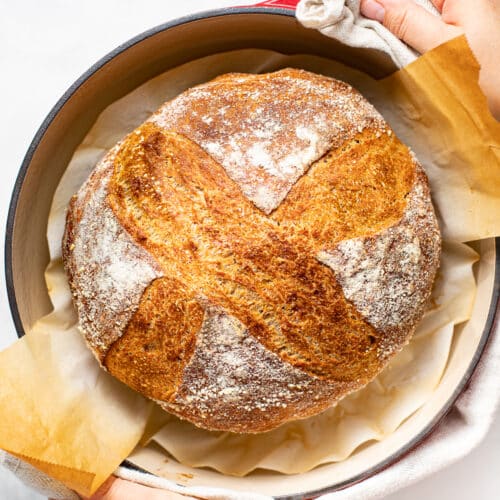
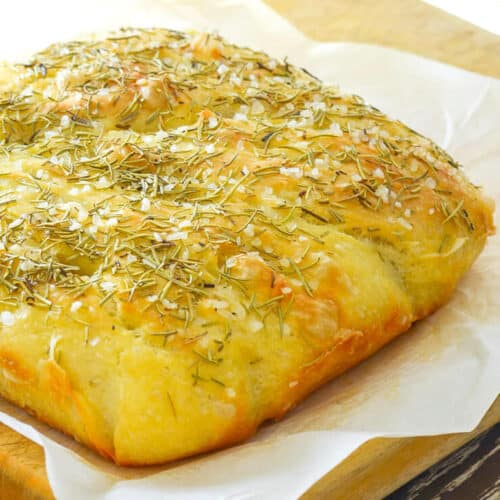

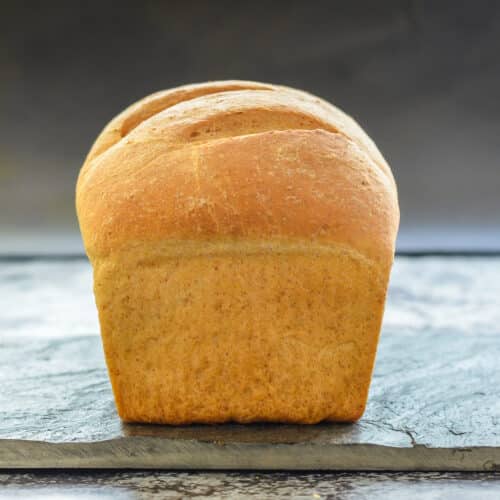
Tonya says
I bought a sourdough starter from a gift shop while in Alaska about 8 years ago, I followed the directions but it never really worked well and eventually got moldy.
In the fall my interest in trying again was renewed and I began researching sourdough. After much consideration I decided to follow your no discard method.
The first few days went well but my starter never consistently doubled in 4-6 hours. Although I did see lots of bubbles on the sides or the jar. I continued feeding daily until I’d used a full bag of flour.
I also had to discarded as I ran out of room in my jar. When I discarded I went all the way back to 50g of starter and added 25g rye flour and 25 g water.
I decided our house was just too cool in the winter so I put my starter in the refrigerator and to hibernate until summer.
So, here I am feeding daily, again. I see lots of bubbles but get very little rise.
I’ve played with the temperature, fed 50g, and experimented with tap water vs bottled water. I don’t really want to give up on this but not sure what to do next.
Melanie McDonald says
It might not double in 4 to 6 hours. It could take longer. Sometimes mine takes about 12 hours, sometimes even longer. It depends on the temperature and conditions.
Are you sure you're not missing it? It could be happening while you sleep or are out depending on what time of day you're feeding.
The fact you are getting bubbles shows something is definitely happening.
With a good quality rye flour, good quality water and reasonable temps, making a starter like this should be pretty much no fail. It can't not work.
I would probably try a different brand of rye flour. Are you sure the one you're using is good quality with no additives? That could well the reason you're having issues. If there's not enough nutrition for the bacteria they aren't going to flourish.
Get the new flour and put just 1 tablespoon of the starter in a clean jar then start feeding that 25g + 25g of rye flour and water.
If the temp in your house is quite cool (less than 20 degrees celcius) then keep your starter in the oven with just the light on and see if that helps.
Dorothe says
Hallo, I started my starter last Friday 6-23-23 am now on my 5th day. Since yesterday I find that the starter has a white film over it, I am really concerned that it is mold.. it smells more like nail polish- I heard that’s when it’s hungry, so is this just dried stuff on top and telling me it’s hungry or is this Kahm yeast or well mold? I’ve got also another established starter that I bought and just deeded, it’s 2 months old and that never had that film.. I’d love to send a pic..
Paula says
I left it for 6 weeks in fridge and went to start it up again to make bread. For 3 days all went well and it was doubling. Fourth day I forgot to zero scale before adding some flour. Dumped some out, though some stuck and made my best guess as to correct grams. Added water in proportion as best I could. It is bubbly but not doubling in a few hours like it was. So, I fed it way early, 8 hours. It is still not doubling in a few hours like before. Also has required amount of starter for baking bread. Any suggestions?
Thanks,
Paula
Melanie McDonald says
If it was doubling for a few days then it sounds like it's alive and kicking. In this case I would recommend getting a fresh clean jar and adding just a teaspoon of the starter you've built up. No need to be super exact. Just eyeball it. Start feeding the new jar 25g of flour/water every day and you'll probably find it springs back to life really quickly. Use up the old jar in a discard recipe or add it to a regular yeasted loaf of bread for some extra flavour. Good luck!
Liza says
Thank you so much for your very helpful recipe! My starter is 6 days old, but it smells very strongly of nail polish remover from about 12 hours after I feed it, until I feed it again. I read that you said it means that it is hungry. Should I then feed it sooner or still wait 24 hours? Thank you!
Melanie McDonald says
As long as you're following the instructions to the letter and using rye flour there is no need to feed it earlier. If you did you wouldn't be able to keep it no waste. Trust the process. As long as it's happy and active don't worry about the smell.
Anne says
Hi,
My starter did great the 1st couple of days and then slowed down. It would rise but never double after day 4. I took some of the old starter on started feeding it. Again it did great the first 4 days. Do I feed the 2nd batch and start as day 1? Or is the second batch ready as soon as it doubles?
I'm using organic rye flour and bottled room temp water.
Melanie McDonald says
As per the instructions, it can be normal for it to go quiet and not do much for a while at around day 4. Just keep going and trust the process. You don't need to be removing anything from the jar. As for when it's ready, as per the instructions, "Once your starter has been rising and falling consistently after feeding for a few days it is ready to bake with.".
Beth L says
I’ve been baking bread for over 40 years, and finally have a successful starter sitting on my counter! Can’t thank you enough for the detailed and easy to understand explanation of the process. Absolutely love the no- waste method - just baked my first loaf and have a small amount going into the fridge for next weeks bake. Your cookbook arrived today and a quick glance tells me I’m looking forward to each and every recipe. Thanks Mel, you’re the best!
Melanie McDonald says
I love that Beth, thank you, and I'm so pleased you've got yourself a thriving little starter. Hope you enjoy cooking from my cookbook!
Jacquie says
Hello/ today is day 6 for the starter and it is coming along nicely. I think I will wait until day 8 or 9 to bake my first loaf! I think I would like to dry some on parchment paper for back up. My question is how many grams should I dry and then how would I go about waking it up? Would I put enough flour and water to make 110 grams of starter for a new loaf with say a little extra to keep it going! Do I do it over 1 day or over a few days?
Thank you for the recipe, I am excited to try it as I have never really had good results with other discard recipes.
Melanie McDonald says
Glad it's coming along well! If you want to dry some all you need is a teaspoonful. Smear it on the paper, let it dry completely then store in a sealed container or bag to keep it dry. It will keep pretty much forever. To wake it up just start the process of making a new starter with 25 grams of rye flour and 25 grams of water but add your dried piece of starter to the mix too. Feed it for a couple of days with 25 grams of flour/water to build up its strength. It should get strong and bubbly really quickly. Once it is, feed it up with enough to make your first loaf and you're good to go!
Jacquie says
Thanks so much for getting back tome with the info! It was very informative.
Paula J Schmidt says
Can you keep more than scrapings, like 1/2 cup and put it in the fridge?
Thanks,
Paula
Melanie McDonald says
I don't understand why you'd want to? The whole point of this recipe is that there is no discard or extras. You just feed it with as much flour and water as you need to make whatever recipe you are making. The scrapings are all you need to store. Store any significant quantity and you'll end up having to feed it more regularly to avoid it getting really hoochy, stinky, or mouldy, and then you'll end up having to discard which defeats the object of the recipe.
On the odd occasion if you make a mistake with your calculations and end up with some excess, you can store it in the fridge for a few days then use it up in a discard recipe, but if you want to keep your no discard starter healthy long term then you need to just keep the scrapings in the jar.
Paula J Schmidt says
Thank you for answering so quickly.
Paula
Robert Whittle says
How and when can you change from rye flour to all purpose?
Melanie McDonald says
You can't. For this starter to stay healthy and strong without discarding anything it needs to always be fed rye flour. If you want to switch to feeding it another flour you will need to start discarding it. Other flours don't have enough nutrition/food to keep the bacteria happy with this unique method.
Sherry says
This seemed so easy and I love that there is no waste, but I'm completely inexperienced at sourdough. Is it supposed to be a thick as play-doh? I expected it to be wet and bubbly. I'm only on day 3, but it's so dry!
Melanie McDonald says
It's a very thick starter. The consistency doesn't matter though. As long as you're measuring it correctly then you're good. Trust the process!
Lorrinda says
Wow what a great recipe! I made my first loaf of no kneed bread with your no waste starter after you saved the day with your advice on how to turn my seven day "labor of love" starter that I had just finished making and advised me how to take that recipe and transform it into your no waste method at the 7 day stage when I realized it required feedings 2x a day for eternity. Yeah, no thank you very much! Then with the waste from my original starter I made your no kneed bread recipe and the bread is absolutely delightful, quite the real deal! You took the frustration out of my experience making the starter with your personal "in real time" guidance via messaging plus your easy to follow delish bread recipe . Many thanks form this no waste woman!
Melanie McDonald says
Love this! I'm really pleased it's all worked out for you and that your starter is now waste-free and making great bread. Happy baking!
Amanda says
Excellent article. Thank You. Where were you when I was learning how to start a starter?! I maintain a 50g starter and I keep a "discard" jar in the fridge for countless recipes. I have the opposite problem ~ I often find that I am in need of more "discard" for my other recipes!! I prefer to make everything with "discard" because it makes everything healthier and tastier. So I don't understand the no-discard-people...discard pancakes for example were the most tremendous pancakes of my existence and now I can't have them any other way.
Melanie McDonald says
You can still have those extras to make pancakes etc with if you want to. Just feed it extra. Making bread that needs 100g of starter and want to make pancakes that use 50g at the weekend? Feed it 75g of flour, 75g of water. Make your bread and you've got 50g leftover for your pancakes. Just want to make pancakes? Feed it 25g of flour and 25g of water and you've got what you need for your pancakes. This starter is actually more flexible and convenient because you can control exactly what you need and aren't trying to find recipes that work with the amount you've just accidentally found yourself with. You're in charge and not the starter. Hope that makes sense!
Jobie says
Thanks for the detailed instruction. I like the idea of not feeding ad discarding everyday.
Lillie says
I haven't been able to get my starter going. I think my house may be too cold. A few bubbles but no doubling in size. And now there is mold up the side of the container
Brenda says
This is bubbling and rising but tastes foul. I had a spoonful then my husband did. He nearly vomited. There's no way I'm making bread with this.
Melanie McDonald says
Please don't eat raw sourdough starter. It is intended to be baked with, not eaten as it is. Also it contains raw flour which can cause food poisoning.
Jay says
Brenda nooooooo
Kirsty says
Trust the process!
Days 1 to 3 were right on point - then there was NO activity days 4-6 but I kept feeding it as per instructions. Then....THEN.....oh my goodness - IT WORKED!
This is the best recipe and method ever - I have tried 4 times trying to make sourdough and I felt that I would never get it right.
I couldn't be happier. Thank you SO MUCH for sharing this. So generous with your knowledge and very much appreciated.
Just for noting - I live in Adelaide South Australia, it is summer - so the room temperature is a dry 30-40 degrees celcius. I used Wholemeal flour days 1-3 then Rye flour days 4-8.
Melanie McDonald says
Love that - Thanks Kirsty. Enjoy baking with your new friend!
Lina Bedard says
Hi there,
I am on day 5 of feeding the starter 25g of rye flour and 25gr of water each day. It has doubled in size today, I will keep doing the same process until day 7. If at Day 7 it doubles as it has now but I am not ready to bake with it, should I just put the whole jar in the fridge until I am ready to use for baking?
Should I discard any portion of it before putting it the fridge or wait until I bake with it, then use what I need and put the rest back in the fridge.
George says
I made my sourdough starter from organic rye flour.
What I have found, for the best sourdough, mix in fresh flour and water. Daily. Then mix thoroughly, then 3 x longer! Excessive yes, but then every enzyme gets fed and it creates way more gases. Doubling of portion is normal. Peak growth could be 3 x volume. Exactly what is needed for lighter breads.
Zak says
My starter is rather running. I live in a high altitude area. Could that be the reason and how do I rectify?
Can i add only flour to the starter?
Melanie McDonald says
Sorry but I have no experience of making starters or baking at high altitude. It doesn't really matter what the texture of it is like though. It will still work the same. I do wonder why it's runny though. This should be a really thick starter. Are you weighing the water and the flour? A quick Google tells me that usually high altitude would make flour drier due to lower humidity levels so if anything your starter should be thicker not thinner. It makes me think something is off with your measurements.
You can add only flour to the starter but then it won't be a 100% hydration starter anymore (1 part flour & 1 part water). Most sourdough bread recipes call for 100% hydration starter so you will run into issues when you start baking if you change the hydration.
Paula Schmidt says
Mine has a dark grey on top. I suppose I have to start over. I haven't taken out of the fridge since 10/4 to feed it and use it. I had it the lid on loosely. Was that a mistake? Also do I need to feed it more often than that?
Melanie McDonald says
It might just be dark grey because it's really dried out or because there's a layer of hooch on the top. If you're not feeding it for a while it's ok to have the lid on tight so it won't dry out. It only needs to be on loosely so the jar doesn't explode with all of the gas the starter creates when it's fed. If you're not feeding it that's not going to happen. I've kept mine in the fridge completely neglected without feeding it for 6 months and it was fine.
It's hard to say what's going on without seeing it but as long as it doesn't smell foul and just smells yeasty or like acetone it should be fine. You know when they are off because they will either smell absolutely rotten (like foul stinky cheesy feet) or they'll be mouldy. You can't really mistake the bad smell!
If it smells ok, I'd dig a tiny spoonful out from the very bottom and put it in a new clean jar and start feeding that. Compost the rest. The tiny bit should be very active once fed and will be good to go in a few days (assuming it was happy and active before you stored it away).
Paula J Schmidt says
Thank You .
Amber says
I used your recipe to make my starter. It has been a week and has doubled in size. I wasn't going to actually get to use it for a couple days. So just left it alone. The night before I wanted to use it I was going to feed it up with the amount I would need. There was a crust over it. My question is though...was it just a crust or the start of mold. With using rye flour I couldn't really tell.
Melanie McDonald says
It's normal for the top to look a little dry/crusty because it's in contact with the air in the jar. It might sometimes look liquidy or dark too. They are all different and you'll get to know yours. Mold is generally fuzzy and easy to spot and usually by the time your starter is moldy it also smells pretty foul (like rotten cheese) so you can't miss it. Unless you're seeing hairy fuzz then I'm pretty sure yours is fine.